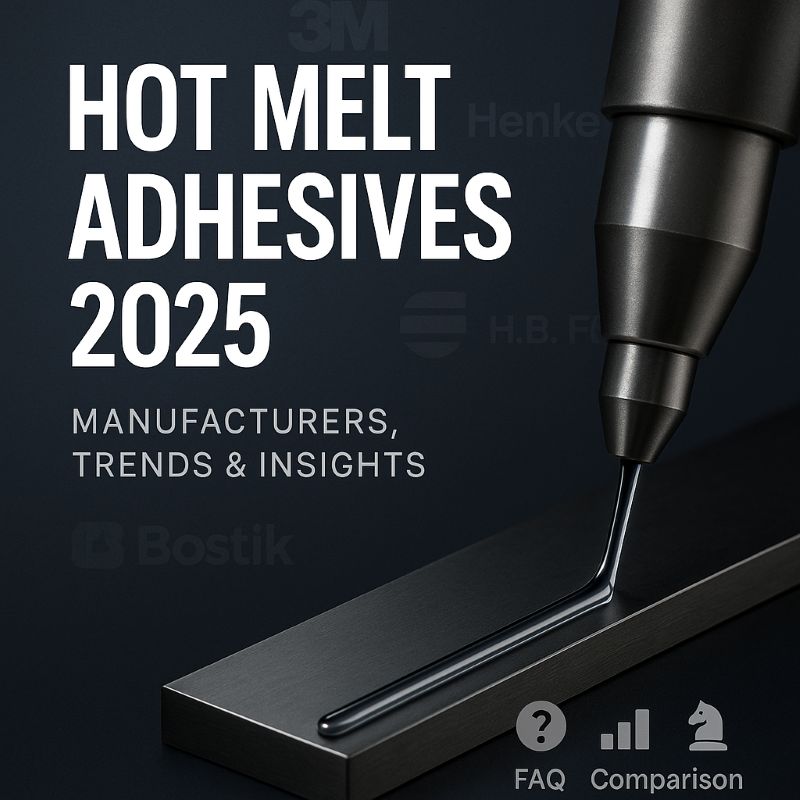
Overview of Hot Melt Adhesives
Top Players in 2025
Types of Hot Melt Adhesives
Importance in Modern Industry
Latest Trends in Adhesives
Comparison Methods
Strategic Insights for 2025
Frequently Asked Questions (FAQ)
Hot melt adhesives are versatile, fast-curing materials widely adopted across industries for bonding, sealing, and laminating. In 2025, technological innovation and rising demand for automation and sustainability continue to drive their development. Manufacturers offer various adhesive formulations suitable for packaging, automotive, woodworking, electronics, and labeling. High-speed production environments particularly benefit from recent innovations that ensure clean bonding, low odor, and minimal residue.
The hot melt adhesive landscape in 2025 is shaped by companies that prioritize performance, sustainability, and system compatibility. Leading producers offer:
Consistent bonding results for packaging lines
High-strength adhesion for mechanically stressed applications
Clean and low-emission bonding for woodworking and panels
Fast-curing adhesives for improved throughput
High-speed and automated system compatibility with low waste output
These players contribute to greater operational efficiency, material compatibility, and reduced production downtime.
Several types of hot melt adhesives are available to meet industry-specific performance needs:
EVA (Ethylene-Vinyl Acetate): Economical and commonly used in packaging.
Polyolefin: Good chemical and moisture resistance; suited for construction and automotive use.
Polyurethane: Flexible and elastic; often applied in textiles and soft goods.
Polyamide: Offers superior heat and chemical resistance; ideal for electronics and durable goods.
Modern polyamide-based adhesives provide clarity, fast flow, and quick setting—ideal for high-volume automated production lines requiring both performance and environmental consideration.
Hot melt adhesives streamline manufacturing processes by:
Reducing downtime due to quick setting times
Supporting high-speed, automated assembly
Enhancing product quality through reliable bonding
Lowering energy use and simplifying logistics compared to solvent-based options
These adhesives play a crucial role in sectors such as consumer electronics, packaging, automotive interiors, labeling, and woodworking.
In 2025, emerging trends in hot melt adhesives include:
Sustainable formulations: Lower VOC emissions and renewable content
Automation-compatible properties: Faster set times and minimal residue
Eco-compliance support: For companies adapting to green regulations
Smart dispensing systems: For accurate and consistent application
These innovations aim to balance regulatory compliance with industrial productivity.
To assess and select the right adhesive solution, manufacturers should consider:
Bonding performance: Adhesion strength under specific stress or temperature
Material compatibility: Suitability for intended substrates
Environmental profile: Emissions, recyclability, and sustainability
Application speed: Compatibility with high-speed equipment
Cost-performance ratio: Total cost of ownership, including waste, rework, and line efficiency
The best adhesives achieve strong performance while simplifying application and reducing operational impact.
In 2025, choosing the right adhesive partner is a strategic decision. Key success factors include:
Expertise in formulation tailored to specific applications
Flexible customization and supply chain responsiveness
Compatibility with global compliance standards
Solutions that reduce operational risks and downtime
Scalable adhesive technologies fit for digital and smart manufacturing systems
By aligning with adaptable adhesive suppliers, manufacturers can better respond to evolving market demands and sustainability goals.
What are hot melt adhesives?
Thermoplastic adhesives that melt when heated and quickly solidify upon cooling, offering fast and durable bonding for industrial applications.
What types of hot melt adhesives exist?
Common types include EVA, polyolefin, polyurethane, and polyamide, each designed for unique use cases such as packaging, electronics, or textiles.
Why are hot melt adhesives critical in manufacturing?
They reduce production time, energy use, and waste while improving bonding strength and process efficiency.
What are current trends in hot melt adhesive technology?
Sustainability, fast-curing properties, and automation compatibility are leading trends across global markets.
How do I compare adhesive options?
Evaluate based on bonding strength, environmental impact, application method compatibility, and total lifecycle cost.
What are the challenges in implementing adhesives for automation?
Ensuring thermal stability, consistent flow, low char formation, and accurate dispensing under high-speed conditions.
What role do hot melt adhesives play in sustainability goals?
They support eco-initiatives through solvent-free bonding, reduced emissions, and compatibility with recyclable substrates.
How is adhesive innovation helping manufacturers scale globally?
By offering cleaner, faster, and more adaptable bonding solutions that integrate seamlessly into automated and smart factory environments.